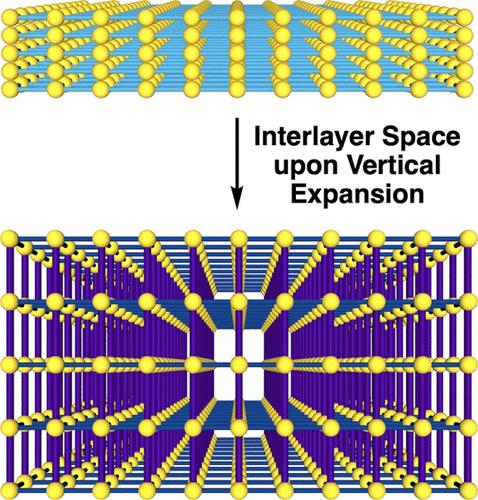Vertically Expanded Crystalline Porous Covalent Organic Frameworks
IF 14.4
1区 化学
Q1 CHEMISTRY, MULTIDISCIPLINARY
引用次数: 0
Abstract
Covalent organic frameworks (COFs) can be developed for molecular confinement and separation. However, their proximate π stacks limit the interlayer distance to be only 3–6 Å, which is too small for guests to enter. As a result, COFs block access to the x–y space and limit guest entry/exit strictly to only the pores along the z direction. Therefore, the extended faces of each layer are hidden between layers, precluding any interactions with guest molecules. Here, we report a strategy for opening interlayer spaces of COFs to attain newly accessible nanospaces between layers. This becomes possible using coordination bonds to replace the conventional π–π stacks between layers. We demonstrate this concept by synthesizing two-dimensional covalent cobalt(II) porphyrin layers through topology-guided polymerization, which were piled up by bidentate axial pillars through coordination bonds with cobalt(II) porphyrin along the z direction, assembling vertically expanded COFs via a one-pot reaction. The resultant frameworks separate the layers with axial pillars and create discrete apertures between layers defined by the molecular length of the pillars. Consequently, the originally inaccessible interlayers are open for guest access, while the polygonal π planes are exposed to trigger various supramolecular interactions. Vapor sorption, breakthrough experiments, and computational studies mutually revealed that the vertically expanded frameworks with optimal interlayer slits induce additional interactions to discriminate benzene and cyclohexane and separate their mixtures efficiently under ambient conditions.

垂直扩展的多晶多孔共价有机框架
共价有机框架(COFs)可用于分子封闭和分离。然而,它们的近似 π 叠层限制了层间距离只有 3-6 Å,这对于客体进入来说太小了。因此,COF 阻挡了 x-y 空间的进入,将客体的进出严格限制在沿 z 方向的孔隙内。因此,每一层的扩展面都隐藏在层与层之间,排除了与客体分子的任何相互作用。在此,我们报告了一种打开 COF 层间空间的策略,从而在层间获得新的可访问纳米空间。利用配位键取代传统的层间π-π堆栈,这成为可能。我们通过拓扑学引导的聚合反应合成了二维共价卟啉钴(II)层,并通过与卟啉钴(II)沿 z 轴方向的配位键将其堆积成双叉轴柱,通过一锅反应组装成垂直扩展的 COF,从而证明了这一概念。由此形成的框架将具有轴向支柱的层分开,并在层与层之间形成由支柱分子长度定义的离散孔隙。因此,原本无法进入的层间为客体进入打开了通道,而多边形 π 平面则暴露出来,引发了各种超分子相互作用。蒸气吸附、突破实验和计算研究共同表明,具有最佳层间缝隙的垂直扩展框架能诱导额外的相互作用,从而区分苯和环己烷,并在环境条件下有效分离它们的混合物。
本文章由计算机程序翻译,如有差异,请以英文原文为准。
求助全文
约1分钟内获得全文
求助全文
来源期刊
CiteScore
24.40
自引率
6.00%
发文量
2398
审稿时长
1.6 months
期刊介绍:
The flagship journal of the American Chemical Society, known as the Journal of the American Chemical Society (JACS), has been a prestigious publication since its establishment in 1879. It holds a preeminent position in the field of chemistry and related interdisciplinary sciences. JACS is committed to disseminating cutting-edge research papers, covering a wide range of topics, and encompasses approximately 19,000 pages of Articles, Communications, and Perspectives annually. With a weekly publication frequency, JACS plays a vital role in advancing the field of chemistry by providing essential research.

 求助内容:
求助内容: 应助结果提醒方式:
应助结果提醒方式:


